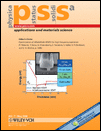Optical study of the AlGaN/GaN high electron mobility transistor structures
Abstract
We present an optical study on three Alx Ga1–x N/GaN high electron mobility transistor structures, which were grown by metalorganic chemical vapor deposition (MOCVD) on sapphire substrates, with different Al compositions using contactless electroreflectance (CER), piezoreflectance (PzR) and surface photovoltage spectroscopy (SPS). The Al composition x can be determined from the band gap energy of Alx Ga1–x N layer observed in CER and PzR spectra. The determination of the built-in electric field strength in the barrier layer (F) has been done by the analysis of Franz–Keldysh oscillations (FKOs) above the Alx Ga 1–x N band gap in CER spectra. A broad feature appeared at energies above the band gap of GaN was observed in each CER, PzR and SPS spectrum. We believe that it is related to the two-dimensional electron gas (2DEG). The energy of the broad 2DEG minimum roughly corresponds to the Fermi energy plus the band gap. The Hall-effect measurements have also been carried out in van der Pauw geometry at room temperature to reveal the sheet carrier density (n s). For the sample with lowest alloy composition (x = 0.07) the analysis of the FKOs yields F = 316 kV/cm at room temperature. When the temperature was cooled down to 50 K the electric field strength decreases to 188 kV/cm. This result can be explained by the change of piezoelectric polarization. (© 2006 WILEY-VCH Verlag GmbH & Co. KGaA, Weinheim)




